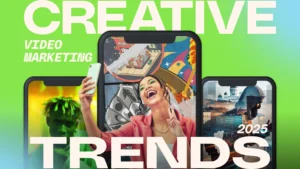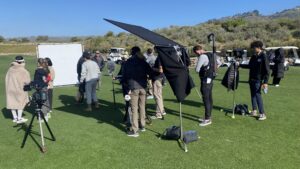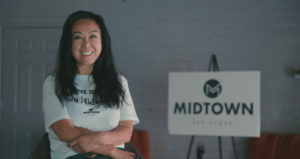As one of the only Las Vegas video production companies with a 1 TON G&E Van in town, we began discussing the production details, scope, and necessary gear. It was decided that we would handle all the lighting and grip on set, typically managed by a Gaffer and Grip, as part of our Las Vegas video productions services.
We jumped right in. The project was a 2-day shoot, with day one focused on a local restaurant, where we showcased the food and chef. As a trusted video production company in Las Vegas, we were ready to handle all aspects of the shoot, from gear to lighting, ensuring everything went smoothly for film production in Las Vegas.

A traditional setup goes something like this.
We get to the location:
Load all the gear in
Start setting up for a specific show. In the beginning on this one we had a proper sit down interview, 2 subjects, so this needed to be properly lit in a restaurant setting also taking into consideration that other restaurant patrons would be on site.
So we decided to go w/ a 4 bank Nanlite Pavotubes , they are full RGB, and allowed us to preset the desired color temperature at the location. Also in order to soften them, we decided to drape unbleached muslin fabric. This makes the lighting more pleasing.

Then on the sides we did a cross key, to fill in the shadows and help out the key. On one side we went with Aputure F22X, and on the other side we had the Aputure 150C with a softbox.
On the front we decided to just rig a light tube to give the image more of a pop and make the whole thing more pleasing. All in all it was a decent setup.

After that we would do patron interviews at the location just talking about food and experience and ambiance. So for this a separate lighting setup would be needed. Something very mobil as the restaurant at that time is open for business and we need to have as little of a footprint as possible.
For something like this we just usually go w/ mobile units, something we can power off a battery and not have to run a stringer, or an extension cord. So tube lights work pretty well just on a c-stand and we usually cross key during these sorta shoots.

Day 2 was a lot more hectic.
Day 2 we had 4 location changes. That means loading in and loading out 4 times. 1 Location was off the strip. a Place called Sparrow and Wolf, knows for their great cuisine and also being off the Strip. Generally this day was going to be filled with doing a bunch of lighting setups for restaurant video interviews as well. But much more than day 1.

This was also going to be a similar type of setup. Get in, setup up all the lights for the 2 person interview, meaning 2 people were going to be on camera. For this one we decided to key with Aputure 600D Pro with china ball. In order to get it out of the frame we put the light onto a combo stand with a menace arm extended out. In order to soften the light and add more color to it , we put unbleached muslin over the diffusion and that knocked the light down a couple of hundred degrees kelvin.

In terms of filling in the light, we did a similar thing with Aputure F22X and Aputure 150C set to about 4800 for contrast.
After the scene was completed we had to load out and move to the next location which was on the trip inside Mandalay Bay Casino, 5 min away from the Las Vegas Airport.
The new location presented its own challenges. Since this was inside a casino setting, we were not able to dim the house or overhead lights so some sort of a solution needed to be worked out.

Since we would not be able to reach 20 ft ceilings, the easiest and fastest solution was to put a tent, which was unbleached muslin over the top of our talent. This softened the light that was coming off the ceiling lights. Overall quick thinking as always saved the day.

Lighting inside operating restaurant is always a challenge. From high contrast of light within the restaurant to daylight seeping in from the outside to the sun movement you have to think very quickly and make sure the listing setup will work for our shoot.
After this location was done we headed yet again to the next restaurant and had to quickly set up the lights in order to shoot a 3 person scene next. This was going to be a sit down interview with a couple of chefs.

Traditionally, when lighting a round table discussion with more than two subjects, one approach is to place a china ball or lantern in the center. This allows light to bounce off the table and fill shadows on talent’s faces. Additional lights from the sides and a soft front light help with falloff.
If you need a Gaffer in Las Vegas video production with a full lighting and grip package, HUSTL Media has you covered. As a leading video production company in Las Vegas, we offer a variety of setups to meet your needs for Las Vegas video productions and film production in Las Vegas. Reach out to us today!
FAQs:
1. What is the best lighting setup for restaurant video production?
For restaurant video production, a three-point lighting setup is ideal, combining key, fill, and backlighting. This setup helps highlight the food, ambiance, and subjects, creating a balanced and visually appealing scene.
2. How can I create a warm and inviting atmosphere with lighting?
To create a warm atmosphere, use soft lighting with warm color temperatures (around 2700K-3200K). Dimmers, diffusers, and practical lights like candles or table lamps can also enhance the cozy and inviting feel.
3. What types of lights are best for filming in tight restaurant spaces?
Compact, portable LED lights such as panel lights, tube lights, or small softboxes are perfect for tight spaces. These lights are easy to position and adjust, allowing you to control the lighting without disrupting the restaurant environment.
4. How can I avoid harsh shadows when filming restaurant videos?
Avoid harsh shadows by using diffusers, reflectors, or softboxes to soften the light. Position your fill light to balance the shadows created by the key light, ensuring even illumination across the scene.
5. What are common mistakes to avoid when lighting restaurant videos?
Common mistakes include using overly harsh lighting, neglecting to balance color temperatures, and failing to adapt lighting to the restaurant’s natural ambiance. Always test your lighting setup and make adjustments to maintain a natural, appealing look.
To book our services, kindly send us an email at Art@HUSTLMedia.com or directly call us at (702) 980 -9620. You may also learn more about us and our campaigns by visiting our website – HUSTL Media.




